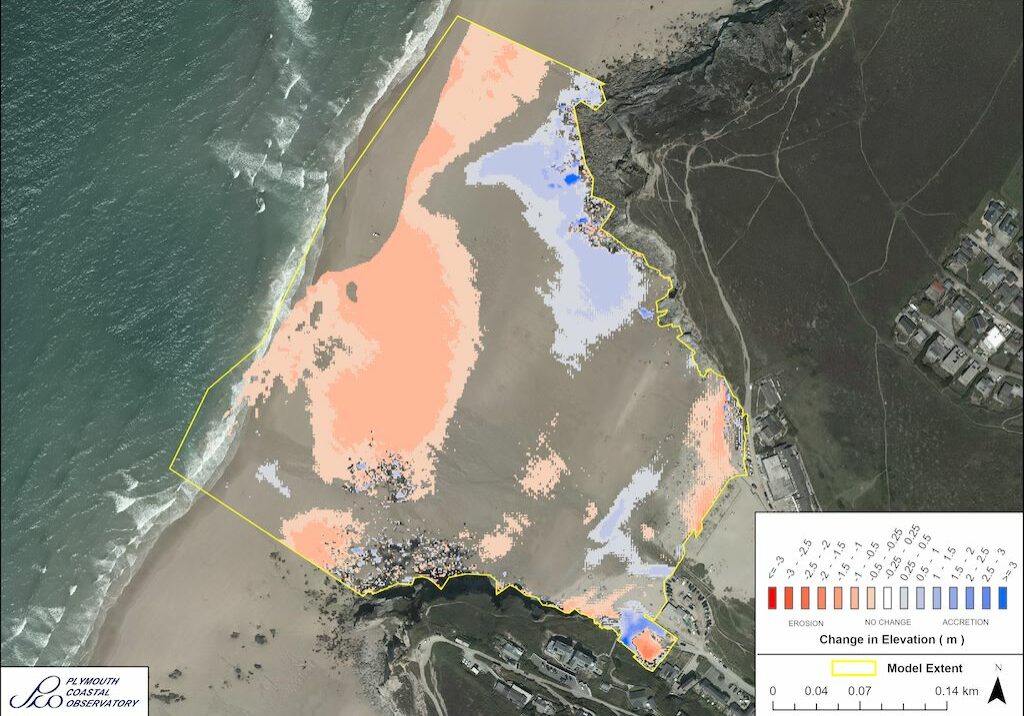
Porthtowan (Cornish: ‘Porth-Tewyn’, meaning ‘cove of sand dunes’) is a north-west facing beach in north-west Cornwall. The beach is located at the mouth of the Porthtowan Stream and Menagissey Stream, both of which flow down short and steep catchments, scarred by the areas rich mining heritage.
The narrow beach sits within a deeply incised valley fringed between the high cliffs of West Cliff and East Cliff. From mid to low tide the beach opens up and to an expanse of sand, connecting Porthtowan to Tobban Horse to the south and Chapel Porth to the north.
The sand associated with Porthtowan rolls back into the remanent of what was a much larger dune system, upon which the village of Porthtowan has developed. There are no hard defences associated with the village so the natural coastal defensive capacity provided by the dunes will, in the future, play an important function in protecting the community behind it.


Coastal Change
The coastline of Cornwall is an ever-changing environment. It is energetic, dynamic, never still and changes with each wave and each tidal cycle. Some of the changes we see are gradual and barely noticeable, whilst others, such as rockfalls, happen suddenly and often shockingly.
From one visit to the next it can sometimes be difficult to see how a beach and dune system has changed, but information has been collected, and is being collected through the Making Space for Sand project, to help us better understand how the coastline is changing. The purpose of this section of the website is to understand each location has changed over time, how it could change in the future and understand the policies that influence how we can respond to these changes.
Shoreline Management Plans (SMP)
The Shoreline Management Plan (SMP) is a strategic planning and management assessment tool that helps identify and measure the risk associated coastal erosion and coastal flooding. The document makes a number of policy recommendations over short, medium and long term timeframes setting out a strategic approach to managing the built, natural and historic environments associated with the coastline. Within SMP there are four policy approaches which have been assigned to stretches of coastlines. The four policies are: No Active Intervention (NAI), Hold the Line (HTL), Managed realignment (MR), and Advance the line (ATL).
Porthtowan sits within Policy Development Zone 11 (PDZ11), in Management Area 29 (MA29), within Policy Unit (PU) 29.4. The policy recommendations for this policy unit are detailed in the table below and the SMP can be accessed through the Cornwall Council website.
Use your touchscreen
to scroll the below table
| Policy Unit | SMP2 Policy Plan | ||||
| 2025 | 2055 | 2105 | Comment | ||
| 29.1 | Undefended cliffs (including cove at Chapel Porth)
Main Policy Sub Policy
|
NAI LAO |
NAI LAO |
NAI LAO |
No active intervention will meet high level objectives and satisfy AONB and heritage coast criteria. NAI would not preclude maintenance of the National Trust owned wall at Chapel Porth. Allow natural coastal evolution to occur to support conservation and designated features. |
| 29.4 | Porthtowan
Main Policy Sub Policy |
MR NF |
MR P |
MR P |
The preferred approach at Porthtowan would be to manage the frontage under a managed realignment policy. This would accommodate the natural variability of this area and allow priority to be given to enhancement of the natural dune system as a UK priority BAP Habitat. There are currently some ad-hoc defences present but these will not prevent any significant erosion. Area is also a World Heritage Site, which should prevent any development encroaching on the dune system. There is likely to be some impact on property, community development and amenities in the medium to long term with this strategy, however the majority of properties in the area will remain unaffected.
|
| Key Main Policy: HTL - Hold the Line, A - Advance the Line, NAI – No Active Intervention MR – Managed Realignment
Sub Policy: LAO – Local Activity Only, NF – Natural Features, P - Placeholder |
|||||


National Coastal Erosion Risk Mapping (NCERM)
National Coastal Erosion Risk Mapping (NCERM) provides a baseline of coastal erosion, for the coastline of England, over short, medium and long-term timeframes. The data is based on the natural and defence characteristics of the coastline and provides rates of erosion at differing levels of confidence to help better plan for worse case scenarios. The data provided is for guidance and does not estimate the absolute location of the future coastline.
The basic NCERM lines show erosion estimates for the Short Term (ST-20 years), Medium Term (MT-50 years) and Long Term (LT- 100 years). The data is further categorised by probability: 05 is 5% probability (a 1 in 20 chance of being exceeded) Red Shading, 50 is 50% probability of being exceeded (a 1 in 2 chance of being either exceeded or not exceeded) Orange Shading and 95 is 95% probability (a 19 in 20 chance of being exceeded) Yellow Shading. Click the link below to access the Cornwall Council NCERM Mapping site read the about section then click on layers.
Historical Images of Porthtowan
Historical photographs provide a powerful insight into how the Cornish coastline has changed within the past Century. The Making Space for Sand project are working in collaboration with the Francis Frith collection and have been given permission to share historical images on a number of beaches considered within the project.
In looking back, we can better understand how the coastline has changed, helping us understand not only how the coastal fringe has developed but also the potential future changes that we my observe. When this is considered alongside forecasts of coastal erosion and sea level rise it will help enable us to better adapt to our changing coastline.
Image of Porthtowan Beach c1898 (image courtesy of the Francis Frith collection) and in 2024
Image of Porthtowan Beach c1950 (image courtesy of the Francis Frith collection) and in 2024
Image of Porthtowan West Cliff 1955 (image courtesy of the Francis Frith collection) and in 2024

Modelling Coastal Change
Using data that has already been collected, combined with data collected through the Making Space for Sand project, a series of models will be carried out at each location. This will help us better understand how each location may respond to sea level rise and gain a deeper understanding of how coastal sediments move and behave.
The complexity of the modelling, and the data collection that helps inform it, means that modelling outputs will not be the same on all sites. Some locations will be more thoroughly investigated to understand more complex issues and provide data that can be more widely applied to other sites with similar characteristics.
As the project develops this section of the website will expand, sharing new reports and coastal change projections when they are produced.
LiDAR surveys, which are explained on the Data Modelling page, have been carried out by the South West Coastal Monitoring program at this location. The image shared here visualises where sand has eroded (areas shaded in red) and where it has built up (areas shaded in blue), between the LiDAR surveys carried out in 2003 and 2019. The darker the shade of red or blue the greater the amount of sand erosion or accumulation has been observed. The image helps visualise that beaches are areas that change shape over time and will continue to do so as sea levels rise.




Beach and Dune Ecology
Beaches and dunes represent an important transition between the marine environment and the terrestrial environment. This transition creates a range of special habitats and exposes a range of interesting features, which that can result in these spaces being highly designated and protected. The Making Space for Sand project will survey a number of dune systems. These surveys will help highlight how they may be changing, will identify rare species, will map invasive species, help us understand overall dune condition and identify potential constraints to improving their condition.
There are a range of designations that recognise a variety of different features. There are also a number of dunes systems where data has been collected to understand their habitat value. These are explored, on a site-by-site basis, in the section below.

Designations
Site of Special Scientific Interest (SSSI)
A Site of Special Scientific Interest or SSSI is a statutory conservation designation notified by Natural England denoting protection for biological and/or geological characteristics. The natural wildlife and geological features of SSSI’s are considered to be irreplaceable parts of the national heritage. These are protected in order to preserve their importance, and to prevent damage and development.
Image of waves breaking on a rocky shore
Godrevy Head to St Agnes SSSI
The Godrevy Head to St Agnes SSSI covers an area of 627.4 hectares from Godrevy Towans to the west and Polberro cove to the east. This coastline exhibits extensive maritime heathland and grassland in addition to sand dune and scattered scrub communities. These habitats contain a number of rare plants, and the cliffs, together with the offshore rocks, support large breeding seabird colonies.
Image of marram grass and sea holly growing on Porthtowan dunes
Designated Cornwall National Landscape Area
From November 2023, all areas previously know as Areas of Outstanding Natural Beauty, or AONBs, were re-named National Landscape and in Cornwall became Cornwall National Landscape. However, the Management Plan still references the term AONB as this was formally adopted by Cornwall Council and cannot be amended until the next plan is produced.
Cornwall National Landscape areas are protected landscapes whose distinctive character and natural beauty are so outstanding that it is in the nation’s interest to safeguard them. As such they have been nationally designated by the same legislation as National Parks and have the same status and level of protection.
Image of an assortment of seaweed (Courtesy of Susan Scott)
St Agnes section of the Cornwall National Landscape
The St Agnes section covers an area of 627 hectares, which is 0.7% of the total Cornwall National Landscape. The key landscape characteristics of this section are the dominant large granite intrusions that form the distinctive St Agnes Beacon, which rise from the surrounding undulating coastal plateau. The plateau itself is dissected by small streams flowing to the north coast and outcrops of craggy grey cliffs that slant away from the sea with wide expanses of sandy beach revealed at low tide.
Image of Towanroath Engine House, St Agnes (Courtesy of Andrew Hocking)

Beach Dune Management Plan
Many of the sand dunes and beaches around Cornwall’s coast are experiencing net erosion and sediment loss. This is due, in part, to lack of new sediment input to the shoreline system and rising sea levels. This is a pressing concern as these environments provide protection against the risk of coastal flooding, provide important habitats that cannot be easily recreated elsewhere if lost and help support the regions thriving tourism industry. It is therefore vital that the sand dunes and beaches around Cornwall’s coast are managed in a more sustainable way that balances the combined functions of beach-dune system.
In 2016, Cornwall Council produced Beach Dune Management Plans (BDMP’s) for 10 locations in Cornwall, including one at this location. The aim of the BDMP’s was to:
- Identify the best day-to-day management approach in terms of monitoring and intervention for the beach and dune system.
- Provide a longer-term approach to beach and dune management based upon an up-to-date understanding of coastal processes at the site, as well as predictions of future coastal evolution.
Image of community led planting to encourage dune development at Porthtowan
Where possible, the Making Space for Sand project will use these BDMP’s, supported by the data it collects, to work with landowners and environmental groups to help build more resilient and more biodiverse beaches and dunes that will help protect people and place from coastal erosion.
Sign up to Making Space for Sand
If you would like to get involved in helping to make dunes more resilient and biodiverse, want to help develop coastal adaptation and emergency plans or just want to know more about what the project is learning about coastal change, please click here:








